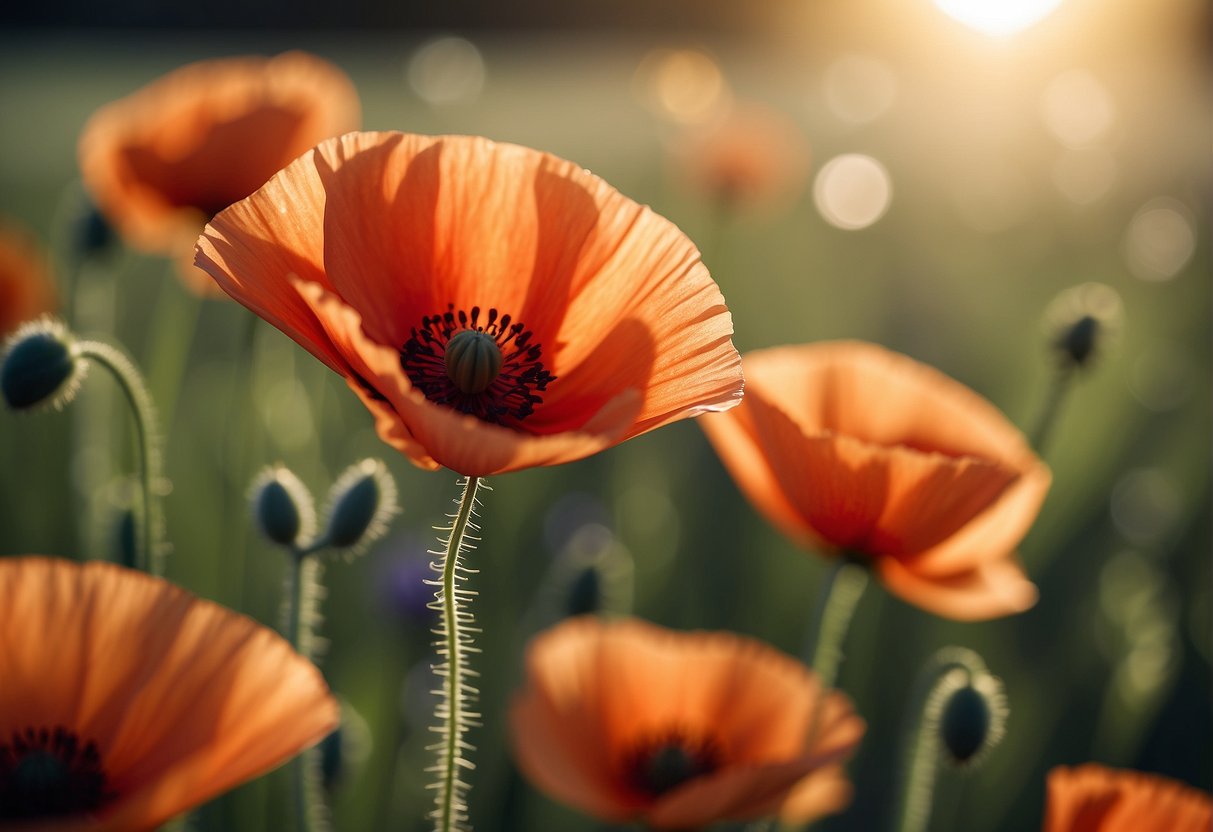Poppies captivate gardeners and nature lovers with their vibrant colors and delicate, paper-like petals. In gardening communities, there’s a common curiosity about the blooming patterns of these flowers—namely, whether poppies grace gardens with their beauty throughout the summer season. As an enthusiastic gardener and flower aficionado, I know that the blooming duration of poppies can widely vary depending on their species.

My experience aligns with the general knowledge that while some poppy varieties, typically annuals, can bloom throughout the entire summer, others, like perennial species, have a more limited blooming period.
Generally, my annual poppies keep producing flowers if I look after them well—particularly with regular deadheading to encourage further blooms. It’s a different story for perennials like the Oriental poppy, which often boast a glorious but brief display that doesn’t stretch throughout the whole summer. Optimal growing conditions play a pivotal role in maximizing the flowering of both annual and perennial poppies. Sunlight, water, and soil quality need to be just right to enjoy these blossoms at their best.
JUMP TO TOPIC
Growing Poppies in Your Garden
To ensure success when growing poppies in your garden, it’s important to understand the various poppy species and their specific needs, provide the correct soil and sun conditions, and follow planting and germination guidelines tailored to these vibrant flowers.
Understanding Poppy Varieties
Different types of poppies flourish at varying times throughout the year. I have found that species like Shirley poppies and P. orientale generally bloom in spring, while other types, such as California poppies, display their vivid flowers in summer. It’s key to choose varieties that will thrive in your regional climate and bloom during the desired timeframe.
Planting and Germination Tips
Planting poppy seeds at the right time is crucial for growth and blossoming. For instance, in my zone 7b garden, I sow poppy seeds in the fall for early spring blooms and again in the spring for summer flowers. Germination can be improved by lightly sprinkling the seeds on the soil surface, as they need sunlight to sprout.
Optimal Soil and Sun Conditions
For the most vibrant poppy flowers and healthy growth, my planting location receives full sun exposure, ideally six hours or more each day. Poppies planted in less sunlight can become leggy and produce fewer blooms.
Poppies prefer well-drained soil to prevent root rot, and regular watering is necessary, especially during dry periods. I ensure that the soil is damp to the touch, but not waterlogged. This balance encourages the most bountiful flowering throughout your desired blooming season.
Caring for Poppy Plants
Poppy care requires a balance of proper sunlight, watering habits, and vigilance against pests and diseases. I always make sure to meet their needs according to these categories to promote a healthy and beautiful bloom.
Watering and Moisture Needs
Poppy plants need well-drained soil and do not like to sit in water. I provide them with enough moisture to keep the soil slightly damp, reducing watering as they mature since established poppies are quite drought tolerant.
Fertilization and Maintenance Tips
I apply a balanced fertilizer sparingly as over-fertilization can lead to excessive foliage at the expense of blooms. Regularly deadheading spent poppies encourages more flowers to form.
Controlling Pests and Diseases
Poppies can be affected by pests like aphids and diseases such as downy mildew. I combat these by practicing good plant hygiene, like removing any affected leaves and avoiding overhead watering which can create a moist environment that pests and diseases thrive in. If an infestation occurs, I opt for organic solutions or insecticidal soaps first before resorting to chemical treatments.
Always avoid overwatering as it is a common cause for root rot in poppy plants.
Poppy Varietals and Their Characteristics
Poppies are a diverse group of plants, with each varietal boasting unique colors and growth habits. Knowing the specifics can help you choose the right types for your garden, from the bright California poppies to the revered Oriental poppies.
Vibrant Colors and Shapes
- California Poppies (Eschscholzia californica): These showcase hues of orange and yellow.
- Oriental Poppies (Papaver orientale): Recognized for their large, bold red blooms.
- Shirley Poppies: These can range from white to pink to red flowers, often with delicate textures.
- Breadseed Poppies: Known for their ornamental and edible seeds, these can be purple, pink, or white.
- Corn Poppy (Papaver rhoeas): Often red and seen in fields and meadows.
Shapes: Petal shapes are generally simple, but some, like the ‘Black Peony’, can have a ruffled appearance that sets them apart. The breadseed varieties, such as ‘Lauren’s Grape’, have single flowers, while others may be semi-double like ‘Falling in Love’.
Annuals Versus Perennials
- Annuals: Varieties like the California poppy and corn poppy are annuals, completing their life cycle within one growing season. They can reseed themselves if the conditions are right.
- Perennials: On the other hand, the Oriental poppy is a perennial, returning yearly and often blooming in late spring or early summer then dying back in the heat.
Annuals tend to have a longer blooming season, often throughout the summer, whereas perennials may have a shorter but more spectacular blooming period.












